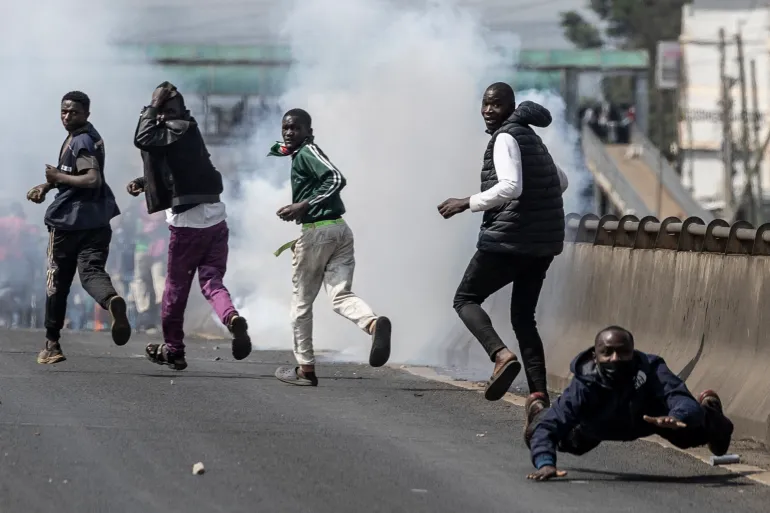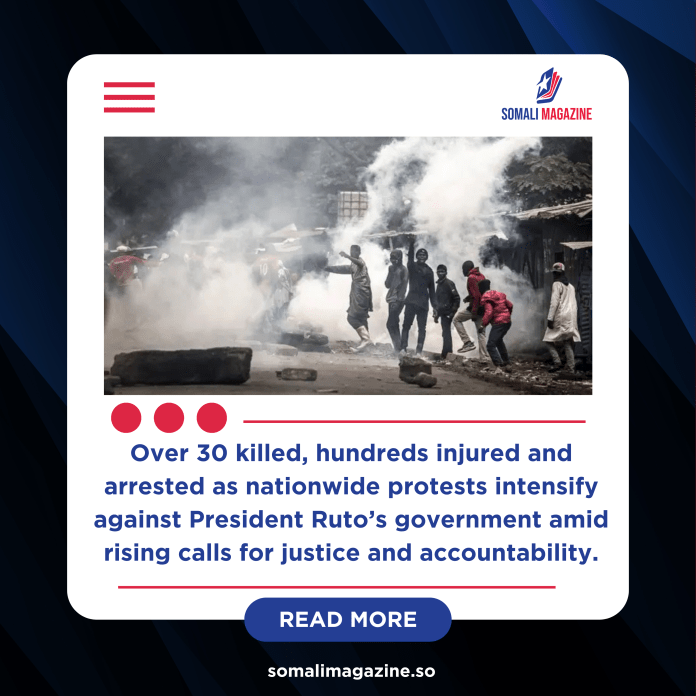Facebook Twitter (X) Instagram Somali Magazine - People's Magazine
At least 31 people have died and more than 100 others have been injured following violent protests across Kenya on Monday, according to the Kenya National Commission on Human Rights. The unrest, which erupted in multiple parts of the country, reflects growing frustration with President William Ruto’s government.
The demonstrations coincided with Saba Saba Day — a national day marking the beginning of Kenya’s push for multiparty democracy in 1990. “Saba Saba” means “Seven Seven” in Swahili, representing the date, July 7. What began as a day to honor Kenya’s democratic struggles turned into a violent standoff between angry protesters and heavily armed police.

In Nairobi, the capital, police blocked access to the city center by barricading major roads and patrolling the streets. From overpasses, they launched tear gas at demonstrators gathered below. Protesters, some throwing stones and others dancing in defiance, stood their ground despite the heavy police presence.
Police reportedly used live ammunition, rubber bullets, water cannons, and tear gas on crowds. The human rights commission also said over 530 people were arrested, and two cases of forced disappearances have been documented.
Many protesters came out in memory of past struggles, but also to demand accountability from the current government. Emmanuel Maranga, a 45-year-old from Kikuyu, said he joined the protest to continue the fight started by past generations. “We can use this Saba Saba to bring change in this country,” he said. “I’m here for the youth. We have to fight for what our parents began.”
Others voiced their anger at recent incidents of police violence and lack of government accountability. “He’s not democratic,” said 32-year-old Dominic Mbuthia, referring to President Ruto. “He doesn’t want to listen to the people. He is a dictator.”
Downtown Nairobi looked like a ghost town. Shops were shut, and groups of men carrying wooden sticks roamed the streets. Many of them claimed to be private security hired by business owners.
Charles Munyao, a businessman in the central business district, said he had to take extra precautions after looters destroyed his shop during protests on June 25. “I lost everything,” he said, pointing at the row of shuttered shops. “If security had been handled better, we wouldn’t have lost our businesses.”
Less than two weeks before this latest protest, another wave of demonstrations broke out nationwide, leaving at least 16 people dead. The anger has continued to grow, partly due to police brutality and the recent death of a popular blogger in custody.
The United Nations also raised concerns about how the Kenyan government has handled the protests. A U.N. spokesperson, Ravina Shamdasani, said it is critical for the government to address the people’s grievances instead of suppressing them.
Human rights groups say abductions and torture of protesters and activists have happened before, especially after the 2024 protests. Dozens were reportedly kidnapped, interrogated, and abused. However, Kenyan police have denied these allegations. President Ruto has also claimed that those who had been abducted were later released.
As protests continue to spread — now reported in at least 16 counties — many Kenyans say they are determined to speak out until meaningful reforms are made. For them, Saba Saba is no longer just a date on the calendar, but a symbol of their ongoing struggle for justice, fairness, and democratic rights.

